
Trout lilies with vinca minor at Silvermine-Fowler Meadow
April is a good month to hunt for native wildflowers in the understory of our woodland preserves. Early spring bloomers take advantage of warming soil and abundant sunshine. The five species highlighted here are ephemeral, meaning that they sprout and bloom before the overstory leaves out. By late spring, when the canopy shades the forest, ephemeral foliage dies back, and the plants become dormant until the following spring.
Spring ephemerals are usually pollinated by early-season native bees, beetles, and flower flies. Bumble bees who are able to raise their body temperatures by buzzing become active before non-native honeybees who are not apt to fly until daytime temperatures reach 55 degrees. Crawling beetles are able to explore ground-hugging plants when the air is too cool for flight.
Some early flowers are capable of self-pollination if they happen to bloom during a prolonged cold snap when insects are not present. This adaptation helps to ensure the species survival; however, cross-pollination by insects is more desirable as it enriches the gene pool. Some ephemerals, such as spring beauties, trout lilies, and bloodroot, close up their petals at night or on cloudy days and re-open them when the sun shines. This enables the plants to conserve their limited supply of pollen for when insects are out and about.

Miniscule red-necked false blister beetles check out this trout lily for pollen
Spring Beauty
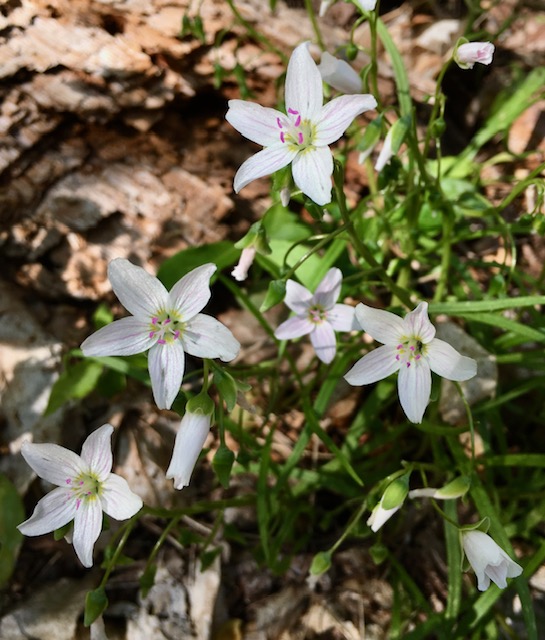
Spring beauties at the Firefly Preserve meadow
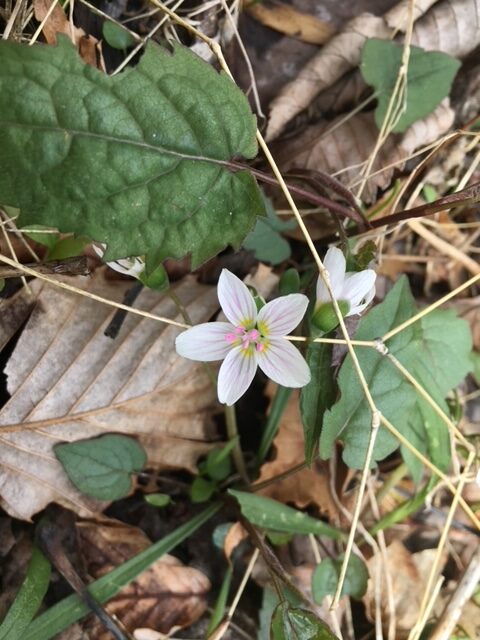
Believe it or not, there is actually a wildflower named spring beauty (Claytonia virginica). It is one of the earliest spring wildflowers to bloom in Connecticut, where it carpets woodlands and meadows before taller plants take hold. Spring beauties have grass-like foliage and tiny 5 petaled pale pinkish-white flowers with pink stamens. The petals sport striped pink veins, which act as guides to lead visiting insects to the source of pollen.
Spring beauties begin blooming when daytime temperatures hover around 52 degrees. Their bloom time is coordinated to the time when their pollinating partners hatch or emerge from winter hibernation. The flowers attract bumblebees, mason bees, bee flies, and other flower flies. The flowers close up at night or during rain.
Trout Lily
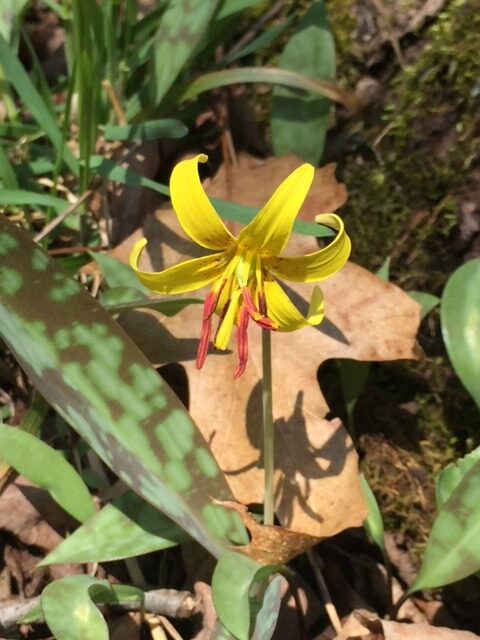
Trout lily flowers
Trout lilies (Erythronium americanum) grow in moist woodlands throughout New Canaan. Old-fashioned names include adder’s tongue and dog-toothed violet, which is a misnomer as the plant belongs to the lily, not the violet family. These lilies are most recognizable by their pointed green and brown leaves, whose mottled appearance resembles the skin of brook trout, hence the name.
Trout lilies form large colonies of mostly single leaves on the forest floor. They grow slowly from bulbs and can take 4 to 7 years to produce a single leaf. Two adjoining leaves are needed before the plant gains enough energy to produce a single flower.
The nodding flowers are bright yellow with dangling orange stamens. They attract pollinators capable of either hovering or crawling to gather pollen. This includes early-season bees and beetles, but not butterflies, who need to land on flowers in order to feed.
Trout lily flowers are often overlooked as the blossoms remain closed on cold, cloudy, or rainy days, which is our typical spring weather. The best time to look for them is on a bright sunny day when the petals fully open to display their pollen. As the flowers hang down, the best view is at ground level, literally on one’s knees.

The single seed pod of a trout lily. The seeds are often harvested by ants
Bloodroot
Bloodroot (Sanguinaria canadensis) is native to eastern North America, ranging from Nova Scotia to Florida and west to Manitoba and Oklahoma. It has deeply lobed green leaves and bright white flowers with yellow centers. Bloodroot blooms briefly in April and May, offering pollen to small foraging bees, especially mining bees. The plant self-pollinates if the weather is particularly cool and no pollinator has visited by the third day of bloom. Soon after, the petals wither.
Due to its short bloom time and tendency to remain closed up when the sun doesn’t shine, bloodroot can be difficult to spot. It is a slow grower, preferring woodland settings where the soil and leaf mulch remain undisturbed year in and out. Under the right conditions, the rhizomes branch out and form colonies. Each plant produces a single seed head which matures by June. The seeds are harvested by ants, who carry them back to their nest. The ants eat the outer covering (elaiosomes) and leave the seeds to germinate and sprout.
Bloodroot sap is poisonous and bright red (‘the color of blood’). The leaves and rhizomes are also toxic, bitter tasting, and left alone by browsing deer and other woodland creatures.
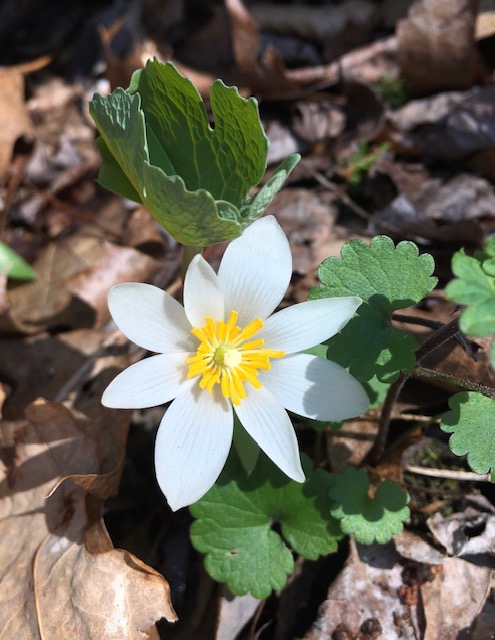
Bloodroot flower in full sun
Red Trillium
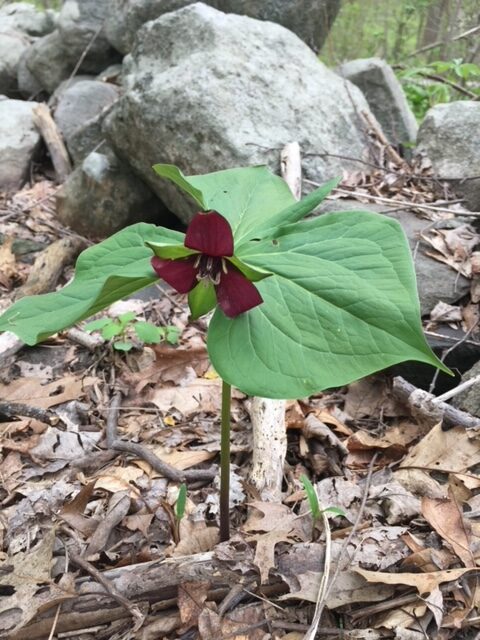
Trillium blooming along the boardwalk at the entrance to Watson-Symington
Red trillium (Trillium erectum) grows in moist acidic soil in partial shade. The plants are slow to develop but can be quite long-lived once established. A single stem with three large round leaves emerges in late April. These leaves resemble jack-in-the-pulpit leaves but are a bit larger.
The deep red flowers, which have 3 petals, open in May, about the time when the forest canopy leaves out. They have a somewhat fetid odor which accounts for the plant’s colloquial name, “Stinking Benjamin.” They mainly attract carrion flies and beetles who are drawn to foul-smelling pollen. After a few weeks, the flowers fade and produce berries, which are eaten by birds and mammals.
Red trilliums are native to the eastern United States. They can be difficult to find in New Canaan as whitetail deer eagerly browse on the leaves.
Canada Mayflower
Canada Mayflower (Maianthemum canadense) carpets the forest floor with colonies of single leaves in mid-spring. As with trout lilies, the plants won’t bloom until they have conserved enough energy to produce a pair of leaves. They are slow growing and prefer undisturbed soil enriched with leaf mulch. Upon reaching maturity, mayflowers produce a single stem with a cluster of tiny star-shaped white blooms. The flowers attract small bees, flower flies, and beetles who visit for pollen. The berries which appear later in the summer are eaten by birds, mice, and chipmunks.
This wildflower is a member of the lily family and is sometimes referred to as the “False Lily of the Valley.” It flourished across much of North America along the Atlantic coast up through New England to Canada and west to British Columbia.

Canada mayflower carpets the forest floor at Silvermine-Fowler Preserve
All photos by Susan Bergen
Loving all that you do for the Land Trust, just taking a look at the writing that you have done.